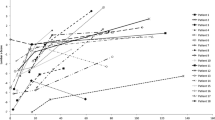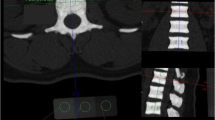Abstract
Background: Increasing numbers of children are being treated with the bisphosphonate pamidronate for low bone mineral density, particularly children with increased risk of fractures caused by bone disorders or low/non-weight bearing. Objective: To determine the effect of intravenous pamidronate on the bone mineral density of children with osteogenesis imperfecta and spastic quadriplegic cerebral palsy. Materials and methods: Charts of 38 children with osteogenesis imperfecta (n=20) and spastic quadriplegic cerebral palsy (n=18) treated with pamidronate were retrospectively reviewed. Patients were selected for treatment because of prior fracture and/or abnormally low bone mineral density. All received intravenous pamidronate at two-month to eight-month intervals and were periodically examined using dual energy X-ray absorptiometry. Results: All patients had abnormally low bone mineral density prior to treatment. Lumbar spine bone mineral density and z-scores showed serial improvement in 31 of 32 patients. Spine bone mineral density increased 78±38.1% in OI and 47.4±39.0% in children with cerebral palsy. The area of greatest lateral distal femur bone mineral density improvement was in the metaphysis adjacent to the growth plate, with a 96±87.8% improvement in the osteogenesis imperfecta group and 65.7±55.2% improvement in the cerebral palsy group. Increases in bone mineral density exceeded that expected for age-specific growth. This was demonstrated by improvement in both spine and femur z-scores for both groups. No children with spastic quadriplegic cerebral palsy experienced fractures after the first week of treatment, whereas patients with osteogenesis imperfecta continued to have fractures but at a decreased rate. Conclusions: Intravenous pamidronate given at 3- to 4-month intervals proved to be effective in increasing bone mineral density in patients with osteogenesis imperfecta and spastic quadriplegic cerebral palsy. The greatest gains in bone mineral density were observed in the children with osteogenesis imperfecta, but they did continue to fracture, albeit at a decreased rate. Children with cerebral palsy gained bone mineral density and did not continue to fracture.





Similar content being viewed by others
References
Henderson RC, Lark RK, Kecskemethy HH, et al (2002) Bisphosphonates to treat osteoporosis in children with quadriplegic cerebral palsy: a randomized, placebo-controlled clinical trial. J Pediatr 141:644–651
Glorieux FH, Bishop NJ, Plotkin H, et al (1998) Cyclic administration of pamidronate in children with severe osteogenesis imperfecta. N Engl J Med 339:947–952
Falk MJ, Heeger S, Lynch KA, et al (2003) Intravenous bisphosphonate therapy in children with osteogenesis imperfecta. Pediatrics 111:573–578
Steelman J, Zeitler P (2003) Treatment of symptomatic pediatric osteoporosis with cyclic single-day intraveneous pamidronate infusions. J Pediatr 4:417–423
Rauch F, Plotkin H, Zeitlin L, et al (2003) Bone mass, size, and density in children and adolescents with osteogenesis imperfecta: effect of intravenous pamidronate therapy. J Bone Miner Res 18:610–614
Rodan GA, Fleisch HA (1996) Bisphosphonates: mechanisms of action. J Clin Invest 97:2692–2696
Grissom LE, Harcke HT (2003) Radiographic features of bisphosphonate therapy in pediatric patients. Pediatr Radiol 33:226–229
Devogelaer JP, Malghem J, Maldague B, et al (1987) Radiological manifestations of bisphosphonate treatment with APD in a child suffering from osteogenesis imperfecta. Skeletal Radiol 16:360–363
Harcke HT, Taylor A, Bachrach S, et al (1998) Lateral femoral scan: an alternative method for assessing bone mineral density in children with cerebral palsy. Pediatr Radiol 28:241–246
Henderson RC, Lark RK, Newman JE, et al (2002) Pediatric reference data for dual X-ray absorptiometric measures of bone density in the distal femur. AJR 178:439–443
Henderson RC (1997) Bone density and other possible predictors of fracture risk in children and adolescents with spastic quadriplegia. Dev Med Child Neurol 39:224–227
Fleisch H (2000) Bisphosphonates in bone disease: from the laboratory to the patient, 4th edn. Academic Press, San Diego
Batch JA, Couper JJ, Rodda C, et al (2003) Use of bisphosphonate therapy for osteoporosis in childhood and adolescence. J Paediatr Child Health 39:88–92
Author information
Authors and Affiliations
Corresponding author
Rights and permissions
About this article
Cite this article
Grissom, L.E., Kecskemethy, H.H., Bachrach, S.J. et al. Bone densitometry in pediatric patients treated with pamidronate. Pediatr Radiol 35, 511–517 (2005). https://doi.org/10.1007/s00247-004-1393-3
Received:
Revised:
Accepted:
Published:
Issue Date:
DOI: https://doi.org/10.1007/s00247-004-1393-3




